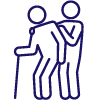- Yokohama-shi Top Page
- Izumi Ward Top Page
- Introduction of the ward
- Overview of Izumi Ward
- Izumi Ward Walking Map
- The second one! Izumi Ward Walking Map-From Izumi Kawakita area to Odoriba area-
Here's the text.
The second one! Izumi Ward Walking Map-From Izumi Kawakita area to Odoriba area-
Last Updated December 13, 2023
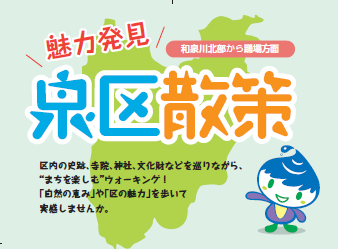
The second one! “Discover charm” Izumi Ward Walking Guide (Izumi Kawakita Club to Odoriba area) was created.
Walking around the historic sites, temples, shrines and cultural properties of Izumi Ward!
This time, we described the location of the toilet, the actual distance, and the approximate number of steps.
Why don't you walk to find your own "the charm of Izumi Ward"?
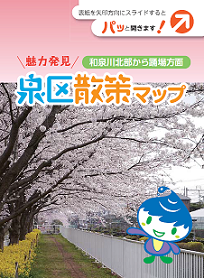
[Distribution location] Distribution has ended due to out of stock.
Izumi Ward Office 1st floor
●Izumi inhabitant of a ward activity support center
●Public Relations Section
3rd floor of Izumi Ward Office
●Regional Promotion Division
"Discover charm" Izumi Ward Walking Map ~ From Izumi Kawakita area to Odoriba area ~
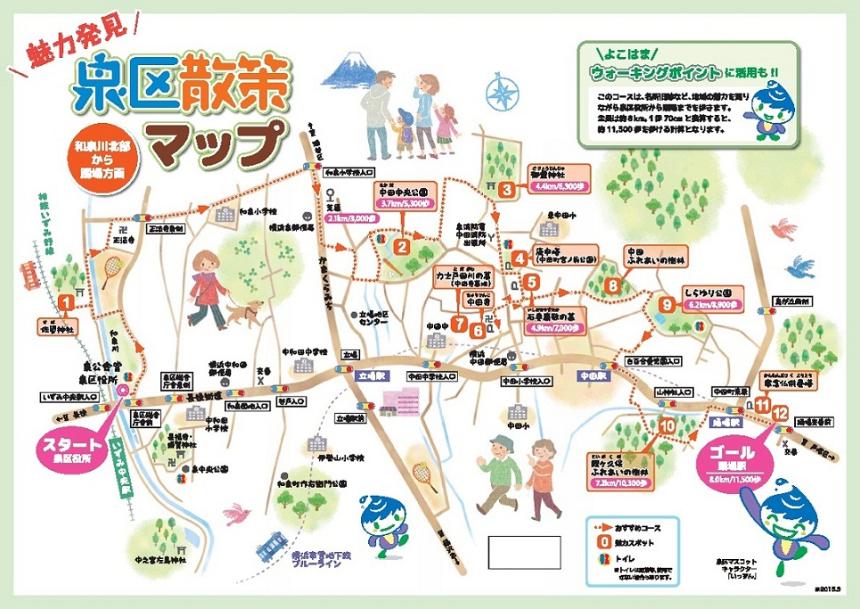
Highlights Information
Here are some of the highlights (numbers) in the map.
1: Saba Shrine
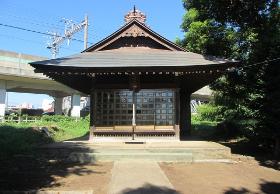
Saba Shrine is one of the Saba Shrines dedicated to the left horse head and Mitsunaka Minamotono. When it was erected, it was enshrined on a hill overlooking the paddy fields opened along the Izumi River. It is said that the name "Kanda" around Saba Shrine is derived from the fact that there was a paddy field that grows rice to be offered to God. The tabunoki in the precincts is designated as a famous tree Furuki in Yokohama City.
2: Nakata Chuo Park
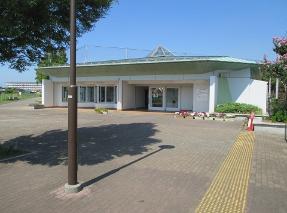
It was opened in May 2001 as the third district park in the city. It is a park with a full-fledged baseball field, a rest house and a parking lot. In the park, the Muraoka River flows and there is a coppice forest, so you can easily stroll through the park.
3: Gorei Shrine (Goryoji Temple)
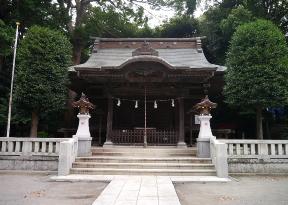
The gods of the gods are the two pillars of Gongoro Kamakura Keimasa and the only thing that can be beaten in Japan. One of the many sacred shrines in Kamakurago. The small tiled building on the right side of the worship hall was the Hoanden of Naka Wada Elementary School until the end of the war in 1945 (1945), and it is the oldest wooden school building in the ward. On the grounds are Benten Pond, the symbolic headwaters of the Muraoka River (Udagawa River), and the oldest stone Koshin Tower in Izumi Ward (Tangible Cultural Property designated by Yokohama City).
4: Koshin Tower (Miyanomae Park, Nakadamachi)
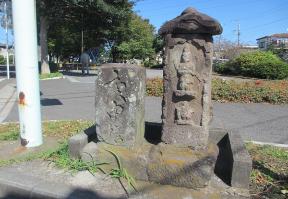
Two Koshinto towers stand at the southern end of Nakadamachi Miyanomae Park, beside the traffic pillar at the entrance of Higashinakada Elementary School. The larger one was built in February 1702 (1702), and the smaller one was built in February 1860 (1860), and it was engraved with Minami Fujizawa Road and Kita Hachioji Road, and the signpost is also used. This signpost indicates that there was a time when the old "Oyamado" that crossed Shirayuri from Tozuka, the east-west road, passed here.
5: Tomb of Yasutaka Ishimaki (Yasutaka Ishimaki)
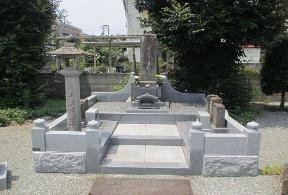
Yasumasa Ishimaki's house, who became the lord of Naka-Tamura during the Edo period, was a house that worked for generations in Hojo Odawara and the county in Sagami Nishi-gun during the Warring States period. Yasutaka spent 23 years at the Ishinomaki-kan in Nakata, focusing on the development of the village. . He died at the age of 80 on October 1, 1613 (1613), and is sleeping in this area where Kannondo, the holding Buddha, was located. The tomb is registered as a historic site of Yokohama City.
6: Nakatadera (Chudenji)
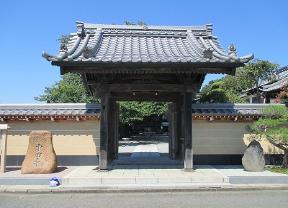
Yasutaka Ishimaki, the lord of Nakatamura during the Edo period, was founded, and was founded in 1612 by Honyo Ryokaku Shonin. It is a temple of the Jodo sect that puts the statue of Amida Nyorai. On the precincts, there is Inaba-do, which has the eleven-faced Kannon, which was the Buddhist temple of Yasumasa Ishimaki, and the 17th priest, Kagawa Ho (Kagawa Ho) Takashi, engraved with "Minami Amida Buddha". There is a ancestral monument, Ryoto Ryojin Tomb of the Toda River from the Kojima family, Ryojin Tomb.
7: Tomb of the wrestler Toda River (Naka Tadera Cemetery)
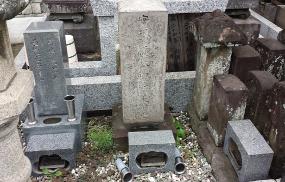
Todagawa Washinosuke was born in Koyamaya in Nakata in 1735 (1735). At the age of 19, he was introduced as a disciple of the second generation Tamagaki of the prestigious Edo corner world, and in May 1756 (1756), he was small in the four-legged name of Todagawa Washinosuke in the upper number, and at the Kyoto box office the following year It became Sekiwaki. After that, he became the master of Tamagaki and named the third generation of thunder (Ikazuchi) Gonta, who was named by the leading person in the corner world, realized the Shogun Ienari Tokugawa (Joran) sumo wrestling, and built the golden age of sumo. .
8: The forest of Nakata Fureai
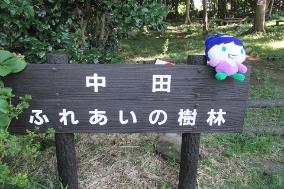
It is the second "Fureai Forest" opened in Yokohama, and is located on a gentle west-facing slope. Surrounded by residential areas, it is as small as 0.8ha, but you can enjoy wildflowers such as spinach. In addition, you can see birds such as Kogera, making it a place for visitors to relax.
9: Shirayuri Park
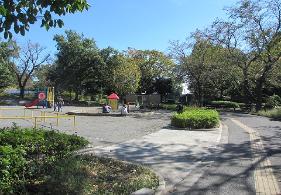
It is close to Nakada Station and is one of the largest parks in the city. Shirayuri Park, Pool, and Aijien Shirayuri were places where Kuwabara (Kuwabara) units practiced during World War II. "Shirayuri" is said to have been named after the Shirayuri Farm, which was established in 1945 by the baby/infant Protection Association to rescue malnutrition baby/infant. It is also known as a famous spot for cherry blossoms in spring.
10: Koiga Kubo (Koigakubo)
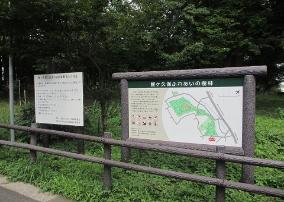
The forest near Odoriba Station was opened in 1995 and has an area of 1.4 hectares, making it the largest natural contact zone among the three forests in Izumi Ward. It is a bright forest mainly composed of kunugi and konara. We sometimes see birds such as white-eye. There are few undulations and you can take a walk comfortably. On the north side, there is a waterway along the forest, and Shimizu flows quietly.
11: Memorial Buddhist memorial tower
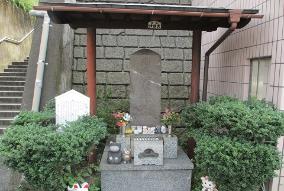
There is a memorial tower for the Kannen Buddha at the entrance of Odoriba Station. It is said that this tower was erected as a finish in November of the lunar calendar in 1737 (1737) when five monks, including the priest of Nakatadera, trained in Nenbutsu. According to the popular theory, I am a cat, and I am a cat, a young girl singing and dancing crazy appeared every night, and the towels of the bean squeeze continued to be stolen. It is also said that the priest of Nakatadera built this tower.
12: Yokohama Municipal Subway Odoriba Station
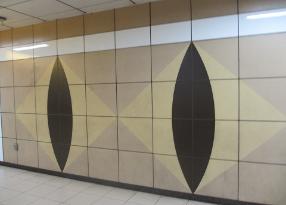
Ooba Station opened on August 29, 1999. A long time ago, the legend that cats gathered and danced every night is the origin of the name "Odoriba". After that legend, a lot of cats are designed on the premises. You can also enjoy while searching for where the design is.
In 2000, it was also selected as one of the "100 Kanto Stations" (Kanto Transport Bureau, Ministry of Land, Infrastructure, Transport and Tourism).
※“Attraction Discovery” Izumi Ward Walking Map (from Izumi Kawakita area to Odoriba area)”
Contact information
Regional Promotion Division inhabitant of a ward business (309 on the third floor)
Telephone: 045-800-2392
FAX: 045-800-2507
You may need a separate PDF reader to open a PDF file.
If you do not have it, you can download it free of charge from Adobe.
![]() To download Adobe Acrobat Reader DC
To download Adobe Acrobat Reader DC
Inquiries to this page
Izumi Ward General Affairs Department Regional Promotion Division
Telephone: 045-800-2391
Telephone: 045-800-2391
Fax: 045-800-2507
Email address: iz-chishin@city.yokohama.lg.jp
Page ID: 616-258-026








